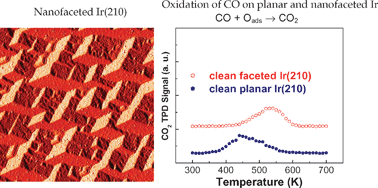Abstract
Faceting is a form of ![[3 with combining macron]](https://www.rsc.org/images/entities/char_0033_0304.gif) 1), are morphologically unstable when covered by monolayer films of oxygen, or by certain other gases or metals, becoming “nanotextured” when heated to temperatures above ∼700 K. Faceting is driven by surface thermodynamics (anisotropy of surface free energy) but controlled by kinetics (diffusion, nucleation). Surfaces can spontaneously rearrange to minimize their total surface energy (by developing facets), even if this involves an increase in surface area. In this critical review, we discuss the structural and electronic properties of such surfaces, and first principles calculations are compared with experimental observations. The utility of faceted surfaces in studies of structure sensitive reactions (e.g., CO
1), are morphologically unstable when covered by monolayer films of oxygen, or by certain other gases or metals, becoming “nanotextured” when heated to temperatures above ∼700 K. Faceting is driven by surface thermodynamics (anisotropy of surface free energy) but controlled by kinetics (diffusion, nucleation). Surfaces can spontaneously rearrange to minimize their total surface energy (by developing facets), even if this involves an increase in surface area. In this critical review, we discuss the structural and electronic properties of such surfaces, and first principles calculations are compared with experimental observations. The utility of faceted surfaces in studies of structure sensitive reactions (e.g., CO

- This article is part of the themed collection: Chemistry at surfaces

 Please wait while we load your content...
Please wait while we load your content...